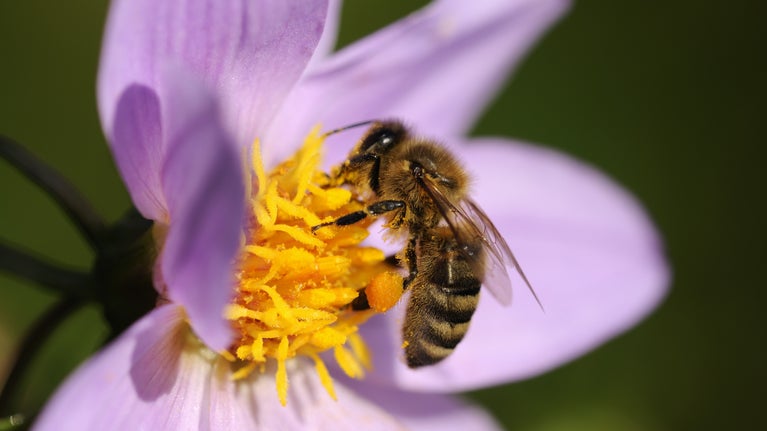
Donate
Everyone needs nature, now more than ever. Donate today and you could help people and nature to thrive at the places we care for.

Our team at Hughenden does a great job of keeping everything at this country estate ticking over. At Hughenden, we're dedicated to preserving its rich heritage, from restoring the historic Castle Gates to conserving statues and even uncovering the fascinating stories behind them, including the intriguing tale of the "Spare Chair," commissioned by Benjamin Disraeli but never used for its intended purpose. Find out how we’re doing our bit for bees with help from our volunteer beekeepers.

This chair commissioned by Benjamin Disraeli in 1832 displaying his campaign colours of pink and white, was made for the December general election. It is affectionately known as the ‘Spare chair’ at Hughenden in reference to the fact that it was never used for its intended purpose. Disraeli finished last in the polling, and as a result was not ‘chaired’ or carried aloft in victory.
In August 2022, the spare chair was sent to the Royal Oak Conservation Studio at Knole to undertake important conservaiton work. The conservation work done to the spare chair included consolidation and stabilisation, removal of remnants of an old plywood label, stabilising the damaged cane seat, and surface cleaning.

The Castle Gates were commissioned by Benjamin Disraeli and his wife Mary Anne as part of their transformation of the gardens and parkland at Hughenden.
Recent research and paint sampling suggest the gates were originally painted black and gilt. This historic scheme was restored as a part of a conservation project which will included the gates’ cleaning, repair, and painting before the details were gilded in gold leaf.

Hughenden has its very own colony of honeybees. It’s looked after by a team of expert volunteer beekeepers in a working apiary, which you can visit. There are several active hives here, as there were in Disraeli's day. These are important at a time when wild bees are struggling with several modern threats including the varroa mite, reduced forage and predators such as the Asian hornet.
The beekeepers regularly monitor the honeybees and manage the hives to keep the colony healthy and happy. They also produce a range of hive products including beeswax candles and delicious honey. The products are available to take home in exchange for a donation and every purchase helps to maintain the Hughenden apiary.

We ask for your permission before anything is loaded, as this content may introduce additional cookies. You may want to read the Google YouTube terms of service and privacy policy before accepting.
Visit the beehives at Hughenden in Buckinghamshire in this behind-the-scenes video from the National Trust. Discover the importance of beekeeping, both ecologically and as a craft, and meet the volunteer beekeepers who dedicate their time and knowledge to help the National Trust care for these precious pollinators.
In spring and summer, we hold scheduled talks where visitors can look inside a full-size model hive, see how it works and try out the specialist equipment, such as honey extractors and smokers, without the fear of being stung.
Keep an eye out on our upcoming events page for further details.

In the past, many large country houses kept bees when sugar was still very expensive and with their vital role in increasing crop yields, they were also an important part of the ‘Dig for Victory’ campaign during the Second World War; beekeepers were given sugar rations to feed the bees with over winter.
When the Disraelis lived here, Hughenden Manor had hives to help increase the yield of the walled garden and fruit trees. Today the volunteer beekeepers keep that tradition alive, while the garden team care for the types of old rose that Mary Ann Disraeli planted in the parterre, which are an ideal source of nectar for the bees.

Conservation work is not just about caring for the precious items in the house collection at Hughenden, garden statuary and sculpture are equally at risk from damage and decay and need protecting in the winter.
Wind-blown pollen and dirt can stick to statues dampened by rain, and animals, birds and insects, not known to be greatly respectful of artworks, and their droppings can encourage the growth of moss, lichen and fungi.
As soon as the weather warms in the spring, the protective covers come off the historic statuary and we begin the process of conservation cleaning.

– Ellen Wood, Senior Collections and House Officer
Next time you’re enjoying the grounds at Hughenden, take a closer look at the statues and think of our team, hard at work with their brushes and sponges. Ask the house team about any of the pieces that capture your interest – there's a tale of romance behind many.
With your ongoing support, we're able to continue our vital conservation work. Thank you for helping to protect these special places.

Everyone needs nature, now more than ever. Donate today and you could help people and nature to thrive at the places we care for.

Find out more about the history that surrounds this estate, from early Domesday records to becoming the home of Queen Victoria’s favourite Prime Minister, Benjamin Disraeli.

Explore the parkland on one of three colour-coded walks, with its carefully designed views, rare chalk stream and medieval church.

Enjoy the symmetrical flower beds, clipped topiary and stonework of the formal garden design, or take a wander through the productive beds of the walled garden.

Find out about the life of Benjamin Disraeli, including his journey from charismatic young politician to twice-serving Prime Minister and his move to Hughenden Manor in Buckinghamshire.

We believe that nature, beauty and history are for everyone. That’s why we’re supporting wildlife, protecting historic sites and more. Find out about our work.

Read about our strategy, which focuses on restoring nature, ending unequal access and inspiring more people.